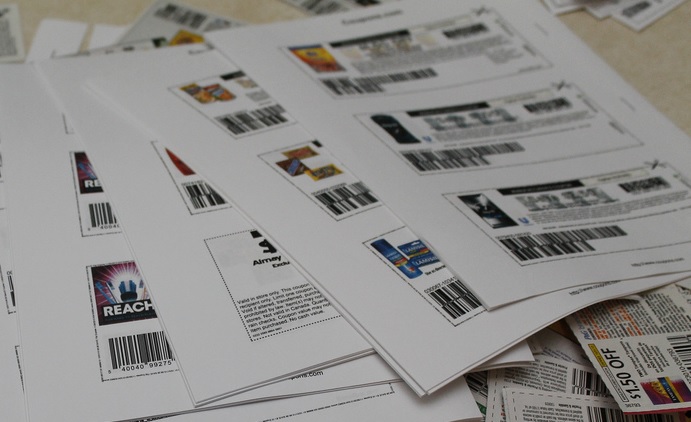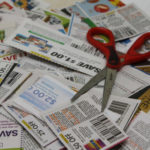
It’s difficult to pinpoint the precise birth date of internet printable coupons, though several online sources declare 1995 to be the year the first true print-at-home coupons appeared.
So it was at the ripe old age of 23 then, that printable coupons were declared dead this week by the coupon processor and analytics company Inmar.
The end came sooner than expected, though it was not a big surprise, since printable coupons had apparently been unwell for some time. In lieu of flowers, Inmar is suggesting you simply switch to digital coupons instead.
“2017 Marks the Demise of Print-at-Home Coupons as Digital Redemption Climbs 67%,” Inmar proclaimed in a news release this week, announcing year-end figures from its new Promotion Industry Analysis. “More shoppers have abandoned their printers in favor of a more convenient, exclusively digital, click-and-save coupon experience,” the release went on to say.
That’s a rather different assessment than the one presented here on Monday, where the takeaway from Inmar’s top-line findings was that digital coupon use was indeed on the rise, but the overall rate of coupon use was down considerably – and not just because of printables.
Printable coupons have seen better years, so this is not the first time an industry participant has pointed to their declining popularity. But it may be the first time one of them has come right out and proclaimed printables dead and buried. So what changed so dramatically last year to prompt this pronouncement?
“Print-at-home coupons declined 43% and began to fade into the sunset,” Inmar CEO David Mounts told Coupons in the News earlier this week. “This is good news for shoppers, retailers and brands as it is the inflection that makes personalization and real-time engagement possible.”
In 2017, Inmar reported that roughly 72.5 million printable coupons were redeemed, which was down just about 9% from the 79 million printable redemptions reported by Inmar in 2016. But that 2016 figure was later revised upward to about 109.5 million. So what initially seemed like a small drop ended up being a more significant 33% decline year-over-year. The 43% decline cited by Mounts occurred specifically in the last quarter of 2017, versus the last quarter of 2016.
But 2016 as a whole may have been something of an outlier. Quotient Technology, owner of Coupons.com, said back then that it had seen a significant increase in printable coupon transactions that year, due in large part to its efforts to improve the ability to print coupons from a mobile device. Quotient’s subsequent efforts to crack down on “coupon fairies” – who bypassed print limits in order to sell hundreds or thousands of printable coupons to buyers who were inclined to use them all – could have contributed to printables’ decline in redemption the following year.
Before all of this, in 2015, Inmar reported that about 73.5 million printable coupons were redeemed, a mere one million more than last year. According to all of these figures, then, printable coupon use indeed declined 33% in 2017 – but only after increasing some 49% in 2016.
So in summary, printable coupons apparently met their demise last year because redemption hit a low point not seen since way back in… well, since 2015. That seems like a much less alarming finding, for those who aren’t ready to see printable coupons’ death certificate signed.
Accounting for each and every one of the billions of coupons used each year is an inexact science, to be sure. If past years’ figures can be revised as new data is taken into consideration, there’s nothing preventing the current year’s figures from being similarly tweaked. So what might first appear to be a minor shift in coupon use can actually turn out to be a major change, and vice versa.
So some aren’t ready to pronounce printable coupons dead just yet.
”We just don’t see it,” Brandi Johnson, CEO of printable coupon provider Qples, told Coupons in the News. “We have not seen a decline in print-at-home redemption rates. Our client base continues to grow.” Printable coupons serve an important function, she said. “Right now, print-at-home is the only way to distribute a coupon online that’s retailer-agnostic,” meaning that it can be used anywhere coupons are accepted – not just in one specific store like load-to-card digital coupons.
Despite those limitations, there does exist a clear trend toward the increased use of digital paperless coupons that even printable coupon providers – like Inmar, which owns Hopster, and Quotient, which owns Coupons.com – are acknowledging. “We believe that the continued digitization of this industry is inevitable,” Quotient Executive Chairman Steven Boal said in 2016.
“They’re right,” Johnson said. “Consumers are demanding digital. But what consumers really want is retailer-agnostic, and we’re just not there yet.”
Many manufacturers prefer digital coupons to their paper counterparts – they’re easier to manage, easier to personalize and less susceptible to fraud. So it’s no wonder coupon providers are extolling the virtues of digital while maligning paper and printables. “For all that marketers are doing, there’s still a tremendous, unrealized sales opportunity as distribution of digital coupons is not keeping pace with demand,” Mounts said.
There is certainly a demand for digital coupons, but there are still plenty of couponers who prefer paper. So when industry leaders are quick to push digital and put down paper, it raises the question of whether coupon providers are trying to give the people what they want – or trying to get the people to want what they’re being given. It seems printable coupons may be falling out of favor somewhat more rapidly among coupon providers than among shoppers – and coupon providers won’t rest until all couponers start agreeing with them.
For now, there are still tens of millions of couponers who are “predisposed to taking a scissor and cutting a piece of paper and taking that in the store,” Boal said in 2016. “So there’s still some opportunity for digital print.”
So don’t abandon your printer just yet. Digital coupons may represent the future. But it seems printable coupons might still have a place in the present.











Pingback: A New Digital Reward Program: The Genius of an App That Counts All Purchases – NEW TIPS
The worst part is that we will all be losing out on savings. Those who could not afford groceries due to high prices before will now suffer even more with the loss of stacking coupons (store + manufacturer) and the limitation of getting only one of the product (one digital coupon). Guess my family will stick to generic brands and forego trying any company’s new product.
Am I sad about this in the long run? No, because I shopped at so many stores that I would not normally go to like Target, Dollar General, etc to get the savings for my family offered by the coupons. Their loss, not mine.
It’s become too much of a hassle/time waster to print coupons that I don’t even waste my time anymore.
Second the above.
Plus digital coupons are almost always single-use, whereas most internet printables are two prints (thus two uses).
Plus some stores that have digital coupon programs take the digital coupons off first (interfering with $ threshold coupons), and some don’t count digital coupons (even digital manufacturer coupons) for their various loyalty programs (like gas discounts) even though they do count the $s taken off via printed manufacturer coupons.
I suspect the biggest advantage manufacturers/stores see with digital is that eventually they can personalize them to the extent that everything varies tremendously based on customer’s past habits – no across the board things, thus they can lower the overall cents off for many, many coupons.
I hate digital coupons. I only use them if there is a freebie deal.
Mostly b/c there always seems to be an issue with an item not coming off, and it’s near impossible to tell after you’ve checked out (versus knowing right away when a coupon beeps).
Then on top of that, you have to have an app for every single store, and then go in and get the coupons,etc.
I find it much eaiser to just print the coupons I see and put them in my purse and then use them at whatever store I am in.
I definitely think this is a case of them trying to make us want something we don’t really want.